Learn how to deal with punctures on long rides with prevention tips, repair techniques, and smart gear choices to keep rolling without stress.
HOW DO I RECOVER PROPERLY AFTER A CENTURY RIDE?
Finishing a century ride is a badge of honor, but what comes after is just as important as the ride itself. Proper recovery ensures you rebuild muscle, restore energy, and prepare for your next challenge. Without it, you risk fatigue, soreness, or even injury. This guide breaks down the essential steps—nutrition, hydration, stretching, sleep, and active recovery—into actionable strategies that help both casual and competitive cyclists recover like pros.

Nutrition after 100 miles
Cycling a century burns thousands of calories, and recovery begins with replenishing what was lost. The body depletes glycogen reserves during such long endurance events, so post-ride meals should focus on restoring carbohydrate levels while also providing protein for muscle repair. Proper nutrition within the first 30–60 minutes after finishing is critical for maximizing recovery efficiency.
The 3:1 carb-to-protein rule
Sports scientists recommend a ratio of three parts carbohydrate to one part protein immediately after endurance rides. This combination accelerates glycogen restoration while supplying amino acids to rebuild muscle fibers stressed during long efforts. Smoothies, recovery shakes, or simple meals like rice with chicken or pasta with beans work perfectly in this window.
Carbohydrates: sweet potatoes, pasta, rice, whole grains
Protein: lean meat, eggs, yogurt, legumes
Healthy fats: avocado, nuts, olive oil
Electrolytes: bananas, coconut water, sports drinks
Recovery doesn’t stop after the first meal. Throughout the day, continue eating balanced meals that emphasize whole foods, hydration, and anti-inflammatory ingredients like berries, turmeric, and leafy greens. These choices reduce muscle soreness and prepare your system for adaptation.
Hydration and electrolyte balance
After 100 miles on the bike, dehydration is almost inevitable. Sweating for hours strips the body not only of water but also sodium, potassium, and magnesium. Restoring this balance is as important as calories because poor hydration delays recovery, affects sleep, and increases the risk of cramping.
Replenishing fluids strategically
The general rule is to drink until urine is light yellow, but cyclists should also pay attention to electrolyte replacement. Simply drinking plain water in large amounts can dilute sodium levels, leading to hyponatremia. Electrolyte tablets, recovery drinks, or mineral-rich foods like spinach and oranges can close this gap effectively.
Add electrolyte tablets to your post-ride water
Consume potassium-rich foods like bananas and potatoes
Include magnesium sources like almonds and dark chocolate
Avoid excessive alcohol, which delays rehydration
Hydration should be an all-day effort, not just a post-ride task. Sipping fluids steadily, combining water with electrolyte-rich beverages, and including water-dense fruits like watermelon supports complete recovery while keeping energy levels steady the next day.
Rest, stretching, and active recovery
A century challenges muscles, joints, and the nervous system. While nutrition and hydration rebuild the inside, stretching and active recovery repair the outside. Without targeted post-ride strategies, stiffness and delayed onset muscle soreness (DOMS) can linger for days, slowing your training progression.
The importance of sleep and mobility
Sleep is the single most powerful recovery tool available to cyclists. Growth hormone, essential for tissue repair, is released during deep sleep cycles. Aim for 8–10 hours of rest the night after your century. Pair this with stretching routines that target hip flexors, quads, hamstrings, and the lower back—areas most stressed by long hours in the saddle.
Use foam rollers on quads and calves to reduce tension
Try yoga poses like pigeon or downward dog for flexibility
Schedule a light spin the following day for blood flow
Avoid total inactivity, which can increase stiffness
Active recovery doesn’t mean jumping back into intense workouts. A 30-minute easy ride, a swim, or even a long walk can stimulate circulation and aid healing. Combining proper sleep, mobility work, and light movement sets the foundation for coming back stronger after the century challenge.
YOU MAY ALSO BE INTERESTED






